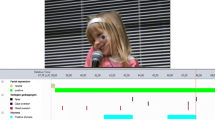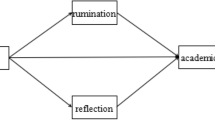Abstract
This study was based upon a cognitive-attentional model of heterosocial shyness, hypothesizing that shyness would be related to self-evaluative attention, while confidence would be associated with task-focused attention. Subjects were 35 heterosocially shy and 37 confident high school boys who conversed with a female confederate under one of three instructional manipulations of attention: self-evaluative, task-focused, or naturalistic. While neither shy/confident status nor the instructional manipulation significantly affected focus of attention during the conversation, correlational support was found for the model. Shy boys had significantly higher levels of public self-consciousness than confident boys. The focus of subjects' thoughts during the conversation was related to self-ratings and judges' global ratings of skill and anxiety, and to actual conversational behavior. In addition, cognitive and behavioral differences between shy and confident subjects were found.
Similar content being viewed by others
References
Arkowitz, H., Lichtenstein, E., McGovern, K., & Hines, P. (1975). The behavioral assessment of social competence in males.Behavior Therapy, 6 3–13.
Blackwell, R. T., Galassi, J. P., Galassi, M. D., & Watson, T. E. (1985). Are cognitive assessment methods equal? A comparison of think aloud and thought listing.Cognitive Therapy and Research, 9 399–413.
Bloom, B. S. (1953). Thought-process in lectures and discussions.Journal of General Education, 7 160–169.
Bloom, B.S. (1954). The thought process of students in discussion. In S. French (Ed.),Accent on teaching (pp. 23–46). New York: Harper.
Burchinal, L. G. (1965). Trends and prospects for young marriages in the U.S.Journal of Marriage and the Family, 27 243–254.
Burgio, K. L., Merluzzi, T. V., & Pryor, J. B. (1986). Effects of performance expectancy and self-focused attention on social interaction.Journal of Personality and Social Psychology, 50 1216–1221.
Cacioppo, J. T., Glass, C. R., & Merluzzi, T. V. (1979). Self-statements and self-evaluations: A cognitive-response analysis of heterosocial anxiety.Cognitive Therapy and Research, 3 249–262.
Carver, C. S., Peterson, L. M., Follansbee, D. J., & Scheier, M. F. (1983). Effects of self-directed attention on performance and persistence among persons high and low in test anxiety.Cognitive Therapy and Research, 7 333–353.
Carver, C. S., & Scheier, M. F. (1981).Attention and self-regulation: A control-theory approach to human behavior. New York: Springer-Verlag.
Carver, C. S., & Scheier, M. F. (1984). Self-focused attention in test anxiety: A general theory applied to a specific phenomenon. In H. van der Ploeg, R. Schwarzer, & C. D. Spielberger (Eds.),Advances in test anxiety research (Vol. 3, pp. 3–20). Hillsdale, NJ: Erlbaum.
Carver, C. S., & Scheier, M. F. (1986). Analyzing shyness: A specific application of broader self-regulatory principles. In W. H. Jones, J. M. Cheek, & S. R. Briggs (Eds.),Shyness: Perspectives on research and treatment (pp. 173–185). New York: Plenum.
Cheek, J. M., & Busch, C. M. (1981). The influence of shyness on loneliness in a new situation.Personality and Social Psychology Bulletin, 7 572–577.
Cheek, J. M., & Buss, A. H. (1981). Shyness and sociability.Journal of Personality and Social Psychology, 41 330–339.
Chiauzzi, E., & Heimberg, R. G. (1983). The effects of subjects' level of assertiveness, sex, and legitimacy of request on assertion-relevant cognitions: An analysis by postperformance videotape reconstruction.Cognitive Therapy and Research, 7 555–564.
Crossley, T. (1977).The examination and validation of attentionally based test anxiety reduction on college freshmen. Unpublished master's thesis, University of New Brunswick.
Crozier, R. (1979). Shyness as anxious self-preoccupation.Psychological Reports, 44 959–962.
Douvan, E., & Adelson, J. (1966).The adolescent experience. New York: Wiley.
Ellis, A. (1962).Reason and emotion in psychotherapy. New York: Lyle Stuart.
Fenigstein, A. (1979). Self-consciousness, self-attention, and social interaction.Journal of Personality and Social Psychology, 37 75–86.
Fenigstein, A., Scheier, M. F., & Buss, A. H. (1975). Private and public self-consciousness: Assessment and theory.Journal of Consulting and Clinical Psychology, 43 522–527.
Glass, C. R., & Merluzzi, T. V. (1981). Cognitive assessment of social-evaluative anxiety. In T. V. Merluzzi, C. R. Glass, & M. Genest (Eds.),Cognitive assessment (pp. 388–438). New York: Guilford Press.
Glass, C. R., Merluzzi, T. V., Biever, J. L., & Larsen, K. H. (1982). Cognitive assessment of social anxiety: Development and validation of a self-statement questionnaire.Cognitive Therapy and Research, 6 37–55.
Havighurst, R. J. (1972).Developmental tasks and education. New York: McKay.
Hersen, M., & Bellack, A. S. (1976). Assessment of social skills. In A. R. Ciminero, K. R. Calhoun, & H. E. Adams (Eds.),Handbook of behavioral assessment (pp. 509–554). New York: Wiley.
Hollandsworth, J. G., Glazeski, R. C., Kirkland, K., Jones, G. E., & Van Norman, L. R. (1979). An analysis of the nature and effects of test anxiety: Cognitive, behavioral, and physiological components.Cognitive Therapy and Research, 3 165–180.
Jones, R. G. (1969). A factored measure of Ellis' Irrational Belief System.Dissertation Abstracts, 29 4379–4380B. (University Microfilms No. 69-6443)
Jones, W. H., & Briggs, S. R. (1984). The self-other discrepancy in social shyness. In R. Schwarzer (Ed.),The self in anxiety, stress and depression (pp. 93–107). Amsterdam: North-Holland.
Jones, W. H., Cheek, J. M., & Briggs, S. R. (Eds.). (1985).Shyness: Perspectives on research and treatment. New York: Plenum.
Jones, W. H., Hobbs, S. A., & Hockenbury, D. (1982). Loneliness and social skills deficits.Journal of Personality and Social Psychology, 42 682–689.
Kendall, P. C. (1984). Behavioral assessment and methodology. In G. T. Wilson, C. M. Franks, K. D. Brownell, & P. C. Kendall,Annual review of behavior therapy (Vol. 9, pp. 39–94). New York: Guilford Press.
Kendall, P. C., & Hollon, S. D. (1981). Assessing self-referent speech: Methods in the measurement of self-statements. In P. C. Kendall & S. D. Hollon (Eds.),Assessment strategies for cognitive-behavioral interventions (pp. 85–118). New York: Academic Press.
Kendall, P. C., Williams, L., Pechacek, T. F., Graham, L. E., Shisslak, C., & Herzof, N. (1979). Cognitive-behavioral and patient education interventions in cardiac catheterization procedures: The Palo Alto medical psychology project.Journal of Consulting and Clinical Psychology, 47 48–59.
Leary, M. R. (1986). Affective and behavioral components of shyness: Implications for theory, measurement, and research. In W. H. Jones, J. M. Cheek, & S. R. Briggs (Eds.),Shyness: Perspectives on research and treatment (pp. 27–38). New York: Plenum.
Leary, M. R. (1987). A self-presentational model for the treatment of social anxieties. In J. E. Maddux, C. D. Stoltenberg, & R. Rosenwein (Eds.),Social processes in clinical and counseling psychology (pp. 126–138) New York: Springer-Verlag.
Leary, M. R., & Schlenker, B. R. (1981). The social psychology of shyness: A self-presentation model. In J. T. Tedeschi (Ed.),Impression management theory and social psychological research (pp. 335–358). New York: Academic Press.
Liebowitz, M. R., Gorman, J. M., Fyer, A. J., & Klein, D. F. (1985). Social phobia: Review of a neglected anxiety disorder.Archives of General Psychiatry, 42 729–737.
McGovern, K., Arkowitz, H., & Gilmore, S. (1975). Evaluation of social skills training programs for college dating inhibitions.Journal of Counseling Psychology, 22 505–512.
Meissner, W. W. (1961). Some indications of sources of anxiety in adolescent boys.Journal of Genetic Psychology, 99 65–73.
Mysaka, M. T., Galassi, J. P., and Ware, W. B. (1986). Comparison of cognitive assessment methods with heterosocially anxious college women.Journal of Counseling Psychology, 33 401–407.
Peplau, L. A., & Perlman, D. (1982). Perspectives on loneliness. In L. A. Peplau & D. Perlman (Eds.),Loneliness: A sourcebook of current theory, research, and therapy (pp. 1–20). New York: Wiley.
Russell, D., Peplau, L. A., & Ferguson, M. L. (1978). Developing a measure of loneliness.Journal of Personality Assessment, 42 290–294.
Sarason, I. G. (1984). Stress, anxiety, and cognitive interference: Reactions to tests.Journal of Personality and Social Psychology, 46 929–938.
Schlenker, B. R., & Leary, M. R. (1982). Social anxiety and self-presentation: A conceptualization and model.Psychological Bulletin, 92 641–669.
Schwartz, R. M., & Garamoni, G. L., (1989). Cognitive balance and psychopathology: Evaluation of an information processing model of positive and negative states of mind.Clinical Psychology Review, 9 271–294.
Steiger, J. H. (1980). Tests for comparing elements of a correlation matrix.Psychological Bulletin, 88 245–251.
Twentyman, C. T., & McFall, R. M. (1975). Behavioral training of social skills in shy males.Journal of Consulting and Clinical Psychology, 43 384–395.
Watson, D., & Friend, R. (1969). Measurement of social-evaluative anxiety.Journal of Consulting and Clinical Psychology, 33 448–457.
Wine, J. (1970).Investigations of an attentional interpretation of test anxiety. Unpublished doctoral dissertation, University of Waterloo.
Wine, J. (1971). Test anxiety and direction of attention.Psychological Bulletin, 76 92–104.
Wine, J. (1980). Cognitive-attentional theory of test anxiety. In I. G. Sarason (Ed.),Test anxiety: Theory, research, and application (pp. 349–385). Hillsdale, NJ: Erlbaum.
Wine, J. (1982). Evaluation anxiety: A cognitive-attentional construct. In H. W. Krohne & L. Laux (Eds.),Achievement, stress, and anxiety (pp. 207–219). Washington, DC: Hemisphere.
Youniss, J., & Smollar, J. (1985).Adolescent relations with mothers, fathers, and friends. Chicago: University of Chicago Press.
Zimbardo, P. G., Pilkonis, P. A., & Norwood, R. M. (1974).The silent prison of shyness (ONR Tech. Rep. Z-17). Stanford: Stanford Univrsity.
Zimbardo, P. G., & Radl, S. (1981).The shy child. New York: McGraw-Hill.
Author information
Authors and Affiliations
Rights and permissions
About this article
Cite this article
Johnson, R.L., Glass, C.R. Heterosocial anxiety and direction of attention in high school boys. Cogn Ther Res 13, 509–526 (1989). https://doi.org/10.1007/BF01173909
Issue Date:
DOI: https://doi.org/10.1007/BF01173909




